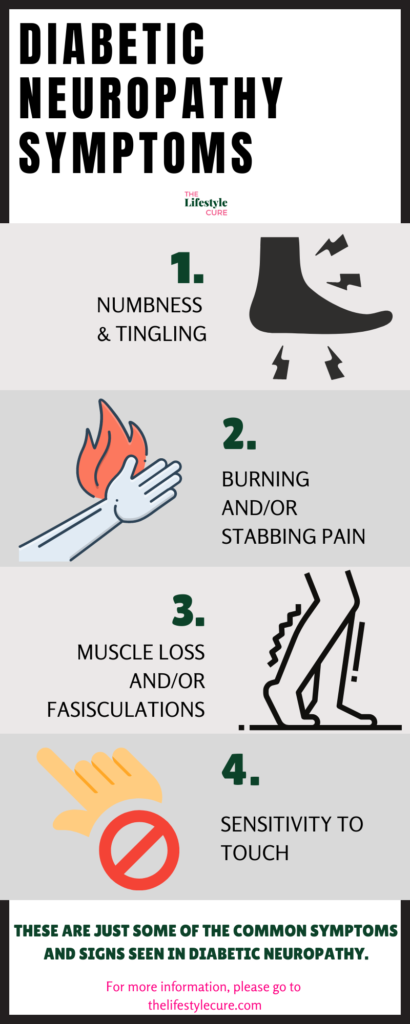As Doctors we write about evidence- based facts and with that in mind select products we believe to be the best for our readers. Thelifestylecure.com is a participant of the amazon associates program and we may earn a very small commission from qualifying purchases at no extra cost to you.
Is it possible? Can diabetic neuropathy be reversed? Can someone with type II diabetes be able to regenerate their nerves after having suffered from nerve damage? The simple answer is yes it is possible. Diabetic neuropathy can be reversed but it can only occur under certain conditions. In some cases, such as with early detection, it may be possible to reverse diabetic neuropathy with alot more ease. If you are in an advanced stage of diabetic neuropathy, then having it reversed may be more difficult and would most likely require surgery. Let’s discuss in detail how, when, and why this may now be possible thanks to the recent advancements in research and development.
Table of Contents
What is Diabetic Neuropathy?
Have you ever experienced that pins & needles sensation in your feet? Or in your hands? How about a burning and/or tingling sensation in your feet?
This sensation may actually be a sign that you’ve developed diabetic neuropathy.
Diabetic neuropathy is a serious complication of diabetes that affects the nervous system. It’s essentially nerve damage that can occur throughout the body but generally begins in the peripheral nervous system. And research suggests that up to 50% of those with type II diabetes will develop peripheral neuropathy in their lifetime. While roughly 30% will experience autonomic neuropathy (these types are discussed in detail below).
Causes of Diabetic Neuropathy
There are certain diabetic neuropathy causes that may seem obvious, such as, having a long standing history of high uncontrolled blood sugar levels. But other causes like having high cholesterol levels in the blood (triglycerides) also play a big role in developing diabetic neuropathy. As well as high blood pressure levels. All these things can lead to serious, permanent damage of the nerves; greatly affecting the ability for diabetic neuropathy to be reversed.
Therefore the main causes of diabetic neuropathy are:
1. Uncontrolled high blood sugar levels
2. Inflammatory processes
3. Reduced blood flow
4. Certain nutritional deficiencies
5. Oxidation
What Else Can Cause Diabetic Neuropathy?
Other causes for neuropathy can be side effects from chemotherapy, as well as certain toxins, and neurological disorders.
Risk Factors for Diabetic Neuropathy
Anyone with diabetes can get neuropathy BUT those that are more likely to get it are those that have:
- Uncontrolled blood sugar levels – this not only puts you at risk for neuropathy, especially diabetic peripheral neuropathy, which is the most common but for all diabetic complications.
- Long duration of diabetes – your chances of developing diabetic neuropathy greatly increase the longer you’ve had diabetes for.
- Kidney disease – diabetes itself puts strain on the kidneys. Therefore having preexisting kidney disease makes it that much worse.
- Obesity – having a BMI > 30 puts you at an increased risk for developing type II diabetes complications (like neuropathy).
- Smoking
Therefore reducing risk factors for getting diabetic neuropathy should be one of the aims once diagnosed with type II diabetes. It is crucial to understand that the above listed risk factors can greatly increase your chance of developing diabetic neuropathy.
The following methods can effectively reduce the risk factors associated with diabetic neuropathy:
- Record a food diary for 5 days. Do not change your diet during those days and try to be as honest as possible while recording what and when you eat food. Notice if what you eat correlates with increases in blood sugar levels.
- Try to keep ensure that you manage your diabetes well more often then not. It can help alleviate some of the adverse outcomes associated with having the disease for a longer period of time.
- Have your urine tested regularly whenever you get your blood work to test what affect the diabetes is having on your kidneys.
- Reduce your weight if you have a BMI >30 especially. This would involve measures listed further below.
- Stop smoking altogether. It is better to go cold turkey.
Diabetic Neuropathy Symptoms
There are 4 predominant types of diabetic neuropathy. And each type has certain symptoms associated with it, however many symptoms overlap between the types as well.
1) Peripheral Neuropathy:
Seen most frequently and experienced in those with a long standing history of type II diabetes. It typically presents first in the feet and then travels up to the legs. This is what people generally refer to as “diabetic leg pain” or “diabetic nerve pain”. From here, it usually proceeds to include the hands and arms. It tends to get worse during the night making it difficult to sleep soundly.
a.) Paresthesia – a type of unusual painless sensation that is felt on the skin. The sensation(s) begins usually with no warning and has a tingling or burning quality. Acute paresthesia happens after applying pressure on a particular nerve for a particular duration of time. Chronic paresthesia is due to a chronic underlying neurological disease or traumatic nerve damage; this is more worrisome.
b.) Numbness or a decreased sensation to pain and/or a change in temperature
c.) Sharp type of pain or cramping of muscles
d.) Increased sensitivity to touch — where some have reported intense pain just from the weight of a bedsheet on them.
e.) Difficult to deal with foot problems like ulcers, infections, and bone and joint pain
2) Autonomic Neuropathy:
This is a serious type of neuropathy because it directly affects the nerves that control several organs within our body. Including the eyes, heart, stomach, intestines, bladder, and sex organs. This can cause:
a.) Decrease ability to adjust from light to dark (night blindness is possible)
b.) A lack of awareness that blood sugar levels are low (hypoglycemia unawareness)
c.) Slow stomach emptying (gastroparesis) leading to nausea, vomiting and loss of appetite
d.) Bladder and/or bowel problems arise
e.) Decreased sexual response
3) Proximal Neuropathy
This type though rare is disabling. It affects the nerves to your chest, abdomen, hips, thighs, buttocks, and/or legs. Usually the symptoms are present only on one side but can spread to the opposite side as well.
Symptoms include:
a.) Severe pain in a hip and thigh or buttock
b.) Followed by weak thigh muscles resulting in loss of muscle mass
c.) Difficulty rising from a sitting position from the weak and loss of muscle
d.) Severe stomach pain
4) Focal Neuropathy
This type derives its name from local damage to one nerve only. Symptoms seen include:
a.) Difficulty focusing or double vision
b.) Discomfort in the form of a dull ache behind one eye muscle
c.) Bell’s palsy is when only one side of the face is paralyzed.
d.) Numbness or tingling in your hand or fingers in all fingers except the little finger
e.) Weakness in your hand that can result in dropping of objects
Diagnosis of Diabetic Neuropathy
The good news is that the diagnosis is generally made directly by your doctor based on your symptoms, history and physical examination findings.
On exam, the following signs will be assessed:
- Whether your blood pressure and heart rate are normal/well controlled
- If there are any changes in skin color and texture of the affected extremities
- Whether or not you have sensitivity to touch and temperature (via monofilament test)
- If you have any decrease in muscle tone
- If an ankle reflex is still present
- And finally doing a tuning fork test to check for vibration status.
And although there is no bad news, most doctors will still conduct confirmation tests if needed. These tests include an EMG (electromyography) study which records how active a muscle actually is and a NCV (nerve conduction velocity) study which records the speed at which signals get passed along the nerve fibers.
Remember, seeing your healthcare provider as soon as you start to feel symptoms is important for early diagnosis to take place. An earlier diagnosis may lead to your diabetic neuropathy being reversed before it progresses further.
Diabetic Neuropathy Treatment
If you are currently facing any type of neuropathic pain, whether that be tingling in your feet and legs, foot cramps, or nerve pain in foot or hand, then you probably jumped straight to this part. Which is understandable because it can be daunting and painful if you are experiencing symptoms and your primary concern is to find some type of relief.
Relief can be found in 2 different forms: 1) getting your blood sugars and cholesterol under control. And 2) home remedies and natural treatments.
1. Controlling Blood Sugars and Cholesterol Levels
The best way to lower your blood glucose and cholesterol levels is by living a healthier lifestyle. That includes changing your nutrition and dietary habits, to be more physically active (which will be discussed further below), to quit smoking, and to better manage sleep and stress levels.
2. Home Remedies and Natural Treatments
This is a great place to start after having gained a sense of control over your blood sugar levels. There are certain supplements, vitamins, procedures (ie. acupuncture) and topical creams (ie. capsaicin) that can help you manage and/or prevent early stages of peripheral neuropathy from progressing rapidly.
i.) Supplements and/or vitamins
Neuropathic pain can be treated effectively when certain vitamins are consumed. And these vitamins are readily available in certain types of food. However, not everyone is able to absorb all of those nutrients from the food they eat. Whether that be from dietary restrictions or from a disease. All 4 of the following supplements/vitamins are supported by research in treating nerve pain/nerve damage due to diabetic neuropathy. While others such as omega 3 fish oil, curcumin, evening primose oil, and acetyl-L-carnitine have shown positive results as well.
ii.) Acupuncture
Has been demonstrated to successfully reduce pain from peripheral neuropathy. Studies have shown how beneficial it is in those dealing with pain associated with diabetic neuropathy.
iii.) Topical creams
Capsaicin when applied topically may improve symptoms of diabetic neuropathy. However, to confirm its efficacy further RCTs (randomized controlled trials) need to be conducted.
iv.) Medications
There are certain groups of medications that are particularly good at controlling and/or managing neuropathic pain. These groups include anticonvulsants (ex. pregabalin, gapapentin etc), antidepressants (ex. cymbalta), opioids and other nonopoid pain relief medications.
v.) Physical therapy
It can help with mobility issues, balance and coordination, and daily functioning. In combination with medication it might also help relieve the following neuropathy symptoms:
- Burning and tingling sensations in the legs and feet
- Muscle cramps
- Muscle weakness
- Sexual dysfunction
Physical therapy leads us directly into the next part of this discussion on whether physical activity can help diabetic neuropathy be reversed.
Can Exercise Reverse Diabetic Neuropathy?
The recommended amount of exercise in a week is 150/minutes of moderate intensity (or two 75 minutes of high intensity) with atleast two strength training sessions. The best way is to build up to these requirements by starting with lower intensity exercises, such as walking, swimming, or stationary biking.
It has been found that regular exercise can reduce the neuropathic pain, specifically pain from diabetic peripheral neuropathy, significantly!
Weight training and resistance training will help support and repair muscle loss, while yoga and core stability will work on balance and coordination issues.
Prevention of Diabetic Neuropathy
Yes, you can prevent diabetic neuropathy by managing your blood sugars (as discussed above) and by taking proper care of your feet.
It’s important to work with your healthcare team to help ensure that you are getting proper foot care. It needs to be a priority once you’ve been diagnosed with type 2 diabetes because uncontrolled diabetes can have damaging effects to the lower extremities resulting in diabetic foot and even amputation. You should have a foot care plan which involves the following:
a.) Check your feet everyday.
Be on the lookout for any swellings, cuts, bruises, blisters, ingrown toenails, athlete’s foot, corns and/or calluses.
b.) Clean your feet every single day.
Make sure to wash them properly; in between the toes, the sole, and heel of your foot, all the way upto the ankles.
c.) While washing your feet, make it a habit to smooth any corn or calluses that appear.
It is advised NOT to cut the corn/calluses but to instead smooth them gently or use corn plasters (medicated pads) or liquid removers.
d.) When cutting your toenails it’s important to do so in a straight line.
Do not trim them in a curved fashion or in any other shape. Always cut them straight across.
e.) Wear protective footwear, including the right socks regularly throughout the week.
The activity that you’re doing should correspond with the appropriate shoes, for example, if you are walking outdoors you should wear fitted but not tight closed shoes/sneakers. And if you are at home, you could get away with letting your feet breathe a little by forgoing socks or wearing ones that aren’t tight.
f.) Protect your feet from extreme changes in temperature.
Whether that be too hot or too cold. Having them remain in a comfortable atmosphere is important in fighting off fungal and other infections.
g.) Keep your blood circulating to the lower limbs.
It’s imperative to have blood flowing all the way down to your feet and then back up. Ensure that it is maintained by elevating your feet if sitting, moving your toes and ankles when possible, avoiding tight socks, exercising, and to give up smoking.
h.) Make it a priority to have your feet checked at every health care visit.
And peripheral neuropathy foot treatments should always begin with conservative measures (i.e. natural remedies) first. They should begin with lifestyle changes to combat uncontrolled or rising blood sugar levels. To the right footwear to decrease chance of infection and then to topical ointments (ie. ones that contain capsaicin as a key ingredient) and/or over the counter pain medications (i.e. ibuprofen, acetaminophen).
Before worrying about having diabetic neuropathy and/or getting it reversed, take control of your health with the above listed measures.
So Is Diabetic Neuropathy Reversible?
There are many sites/sources on the internet that claim that you can “reverse neuropathy in 7 days” which is a nice tagline but not true. True neuropathy will take more than 7 days to reverse.
So although a 7 day reversal of neuropathy may not be possible, there is still hope.
While many report that diabetic neuropathy is a progressive degenerative and irreversible complication of diabetes, this no longer holds entirely true.
More research and neurologists are now classifying diabetic neuropathy into 3 categories:
1) Reversible
2) Partially reversible
3) Almost impossible to reverse
And the treatment will differ depending upon the category you fall in.
Now if you want to to treat diabetic neuropathy effectively it involves looking at the following 5 areas:
1) Normalizing blood sugar
2) Fixing any nutritional deficiencies
3) Decreasing oxidation
4) Reducing inflammation
5) Increasing microcirculation
And what experts are revealing is that when people correct these things, they have improvements in their neuropathic symptoms.
In one study, diabetic neuropathic patients were instructed to have a low fat, high fiber, whole foods, vegetarian diet and exercise for 25 days. 17 out of 21 patients had complete relief of pain in 4-16 days AND their numbness improved overtime. Plus 16 of them had continued relief and/or further improvement even after 1-4 years!
Ways to Improve Your Lifestyle Today
What can you do RIGHT now to make changes to your health for a bright and vibrant future? Begin by working on changing your lifestyle choices today in the following manner:
1) Make the right diet choices
2) Maintain a healthy weight
3) Exercise regularly
4) Avoid or quit smoking
5) Get enough sleep
6) Manage your stress
Incorporating one (or more) of the above listed lifestyle changes into your daily routine can make a huge difference in your life. And perhaps even lead to reversed diabetic neuropathy or atleast better management of the disease.
If you are interested in lowering your blood sugar and reversing your diabetes by losing weight, then be sure to check out our book SMART & Skinny Habits. We designed this program to help diabetics not only lose weight but REVERSE their diabetic symptoms.
Click here for Smart & Skinny Habits now!








